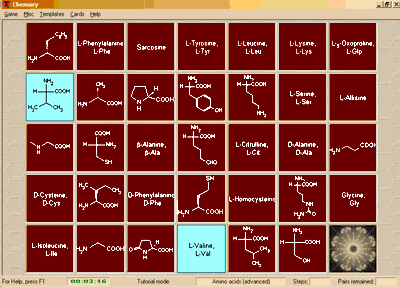Chemistry + learning + fun =

Want to get acquainted with amino acids? Or the different representations of carbohydrates? To learn heterocyclic compounds? Or simply to kill time? Test your chemistry skills in this fun card game.
Chemory is a card game for everybody interested in chemistry, both for students and professionals. The aim of the puzzle is to open and match all of the corresponding pairs of cards.
There are two playing modes: matching of a structure with its name, or matching two structures (i.e. the same compound in different representations). The actual mode depends on the selected template.
Three card setups: 3x4, 6x4 and 7x5 modes.
As the program is intended not only for entertaining but as an education aid as well, beyond the normal play mode, a special reveal (tutorial) mode is available, when the program shows the matching pairs of the cards.
Some templates are easy, some not at all. Sometimes two different names for the same compound are used (trivial and systematic IUPAC or Beilstein, displayed randomly), sometimes the structures are rotated or mirrored randomly (if the structure contains stereo bonds, they will be changed accordingly, so always the same enantiomer appears). Therefore your knowledge of chemistry is very thoroughly tested.
|
|
the free version 1.0.3 (self-extracting installer ~780K) |
|
|
(Currently unavailable, for info please contact) |
|
|

|
Play mode: to play the game and test your knowledge.Included templates:
The same as the registered version, but new template pages cannot be created. |

|
|
T |

|
T |
Download
| Win9x/NT/2000/XP | version 1.0.3 | Release date: 23.01.2005 |
|
|
the free version 1.0.3 (self-extracting installer ~780K) |
|
|
(Currently unavailable, for info please contact) |
|
|
Upgrade of the registered version
Please contact
History
1.0 (14.08.2002) First release.
1.0.1 (03.09.2002) A mistake in the amino acid template has been corrected.
In some screen modes higher than 1152 x 864 the cards were incorrectly displayed - fixed.
1.0.3 (23.01.2005) Mistakes in the namings and drawings have been corrected.
Several new templates have been added to the free version.
A few more options have been added to the edit mode.
1.0.3b (02.12.2006) A few structures have been corrected, a few names have been corrected according to IUPAC rules.
FAQ and info
In the tutorial mode sometimes four cards are highlighted.
This arises from an internal mouse issue in Windows and occurs mainly if the mouse is moved very quickly or one switches to another program and then back to Chemory. If this happens, move the mouse cursor slowly to the bottom (to the taskbar) and click twice on the Chemory button (minimize and restore the program). The highlighting now should be flawless again.
(The highlight is removed when the cursor is over the borders of the cards. If the mouse moves very quickly over the relatively narrow borders, the system hasn't enough time to detect it.)
|
02.12.2006, Maintained with the EditPad Pro |
Return to top |





